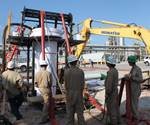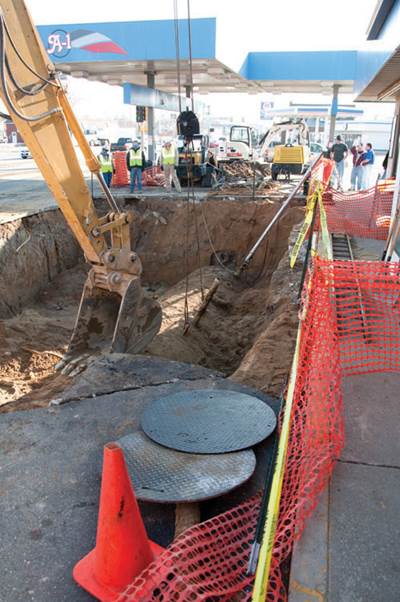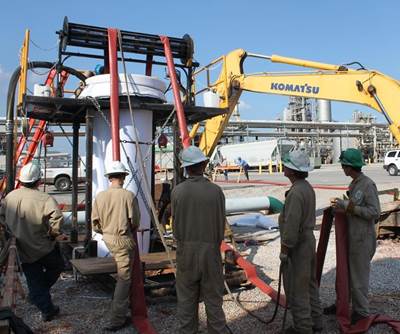Yin and Yang
CT's editor-in-chief Jeff Sloan highlights the beneficial role composites currently play in reducing costs and disruptions in commerce associated with rehabilitation of underground pipe and tanks.
I was asked recently to give a short primer on composites for a webinar targeting designers and design engineers who work mostly with traditional materials like wood, concrete and steel but wanted to learn more about composites. I soon found myself working in PowerPoint, creating one of those advantages/disadvantages slides to describe the Yin and Yang of composites. I settled on an old trick:
Yin: Composites’ advantage is their massive adaptability — multiple combinations of resin, fiber, tooling and processing types are able to meet a variety of application requirements.
Yang: Composites’ disadvantage is their massive adaptability — multiple combinations of resin, fiber, tooling and processing types create complexity that can be difficult to manage and apply, and easy to screw up.
The goal, of course, is to emphasize the Yin. Composites can reduce complexity (in part, through parts consolidation), save weight, increase strength and toughness and prolong product life. But one of the best aspects of composites’ Yin is that they can often eliminate or mitigate the Yang of a legacy process or material.
One legacy process that involves some serious headaches is in-ground pipe replacement. For decades, replacing corroded and/or damaged sewer, water and other underground piping was expensive and inconvenient: Repair crews had to dig up the old pipe and replace it. Such operations block or divert street traffic, seem to take forever and consume a great deal of taxpayer-funded time and manpower.
Into this breach has stepped cured-in-place pipe (CIPP), which allows cities and utilities to reline deteriorating pipe with composites that are cured in-situ, negating the need for large-scale trenching or digging. The “no-dig” composites liner provides a more robust, corrosion-resistant, durable material that promises longer pipe life and a better bang for the taxpayer buck. (See our senior writer Donna Dawson’s CIPP Update, entitled "Cured-in-place pipe: Trenchless trends," under "Editor's Picks" at top right).
But it gets better. There are, in the U.S. alone, 587,000 underground storage tanks that, by law, must be upgraded to monitored double-wall construction to prevent leakage. Tradition says that each tank — most of them of 8,000 to 10,000 gal capacity, used for gasoline storage at retail outlets — must be dug up and replaced. The Yin of composites, however, says no: Like CIPP, an existing tank can be quickly and affordably upgraded with the in-situ addition of a double-walled composite liner, designed to last for at least 30 years. (You can read more about how in-situ repair is cutting costs here by up to 80 percent in contributor Ginger Gardiner's article, "Underground storage tanks: Rehabilitation without excavation," under Editor's Picks.")
The complexity of composites’ Yang might be a barrier of entry for designers and manufacturers used to working with traditional materials, but we are seeing a growing community of material specialists who can bring the best that composites have to offer to bear in new applications every day. Cured-in-place tanks are just one such example. We’ll continue to shed light on these innovations, and do what we can to help you and the rest of the engineering and manufacturing world appreciate and take advantage of composites’ Yin.
Related Content
Your must-have composites industry guide for 2025
Welcome to CW’s annual SourceBook, your guide to suppliers of machinery, materials, software and other services for the composites industry.
Read MoreRevisiting the OceanGate Titan disaster
A year has passed since the tragic loss of the Titan submersible that claimed the lives of five people. What lessons have been learned from the disaster?
Read MoreHow has CW changed in the last year?
Upon his one-year anniversary as editor-in-chief of CW, Scott Francis looks back at some of the brand’s changes and hints at where it might be heading next.
Read MoreAchieving composites innovation through collaboration
Stephen Heinz, vice president of R&I for Syensqo delivered an inspirational keynote at SAMPE 2024, highlighting the significant role of composite materials in emerging technologies and encouraging broader collaboration within the manufacturing community.
Read MoreRead Next
Underground storage tanks: Rehabilitation without excavation
An unusual “lost-core” composite adds double walls protection to noncompliant tanks without excavation.
Read MoreCured in place pipe: Trenchless trends
A variety of CIPP products are enabling the rehabilitation, rather than excavation and replacement, of underground pipe for wastewater and drinking water.
Read MoreAll-recycled, needle-punched nonwoven CFRP slashes carbon footprint of Formula 2 seat
Dallara and Tenowo collaborate to produce a race-ready Formula 2 seat using recycled carbon fiber, reducing CO2 emissions by 97.5% compared to virgin materials.
Read More













.jpg;maxWidth=300;quality=90)








